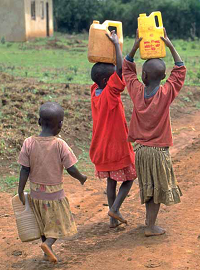Water and Associated Ecosystems

As the principal priority of UNESCO’s Natural Sciences Sector, UNESCO’s freshwater program seeks to develop the tools and skills needed to improve the supply and quality of global freshwater resources.

Water for Life
The UN General Assembly has proclaimed the years 2005 to 2015 as the International Decade for Action, “Water for Life”. The recommendation calls for a greater focus on water-related issues at all levels.
As a result UNESCO actively seeks to develop the tools and skills needed to achieve a better understanding of those basic processes, management practices and policies that will help respond to this challenge.
UNESCO’s commitment
1) UNESCO’s International Hydrological Program (IHP), active since 1965, currently enhances the role of water resources management for sustainable development and adapts the hydrological sciences to cope with the changing climate and environmental conditions. It also integrates the developing countries into the worldwide ventures of research and training.
The current phase of IHP, IHP-VI, covering the period 2002-2007, is devoted to "Water Interactions: Systems at Risk and Social Challenges". IHP is active in a number of joint partnerships such as the following:
ISARM - Internationally Shared Aquifers Resources Management programFRIEND - Flow Regimes from International Experimental and Network DataHELP - Hydrology for the Environment, Life and Policy provide
2) World Water Assessment Program (WWAP) which is a UN-wide program has, amongst its other activities, identified different challenges in achieving sustainable use of water resources. Amongst these challenges are “Sharing Water Resources” and “Ensuring the knowledge Base”, for which UNESCO has assumed a
leading role among all UN agencies.
Sharing Water Resources: Decision-makers must strive to develop policies that allow for sharing among all stakeholders. Within this framework UNESCO has launched the project From Potential Conflict to Cooperation Potential (PC CP). While this effort is relevant to all the challenges, its primary objective is to foster co-operation and mitigate the risk that potential conflicts turning into real ones. The program is currently reviewing case studies of "transboundary" water sharing.
Ensuring the Knowledge Base: National authorities and resource managers need sound scientific data on which to base their projections and decision-making. UNESCO assesses and aims to ensure that each and every community and country can benefit from a whole range of technical and non-technical information and knowledge and apply participate in their development, exchange and dissemination.
Within the same framework, UNESCO has also taken an active role in fighting the two following challenges:
Managing Risks: Water related hazards, such as floods, droughts, tropical storms, erosion and various kinds of pollution should be factored into any integrated approach to water resource management and policy. One way to minimize risk is to develop more capacity in the monitoring and forecasting of extreme events. With this information, appropriate early warning systems and infrastructure can be installed, and new planning strategies devised.
Protecting Ecosystems: The possible negative impact of human activity on the environment must be considered when managing water resources in a sustainable way. Animals and plants, landscapes and wetlands need clean water too. Wastewater must be recycled so that pollution is minimized. Special areas like estuaries, which play an important part in supporting the delicate and complex food chain of many birds and fish, may require total protection.



